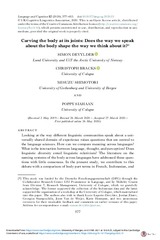Carving the body at its joints: Does the way we speak about the body shape the way we think about it?
Permanent link
https://hdl.handle.net/10037/20555Date
2020-05-26Type
Journal articleTidsskriftartikkel
Peer reviewed
Abstract
Looking at the way different linguistic communities speak about a universally shared domain of experience raises questions that are central to the language sciences. How can we compare meaning across languages? What is the interaction between language, thought, and perception? Does linguistic diversity entail linguistic relativism? The literature on the naming systems of the body across languages have addressed these questions with little consensus. In the present study, we contribute to this debate with a comparison of body part terms in French, Indonesian, and Japanese. Using an updated version of the body coloring task, we observed both diversity and cross-linguistically shared patterns. Importantly, we also observed that speakers of languages which violate the wrist/ankle joint boundary rule do not collapse the distinction in thought. This key finding goes against the conflation of language and thought and leads us to conclude that linguistic diversity does not entail linguistic relativism. Methodologically, we advocate for the use of a culturally neutral etic space as a necessary tool in semantic typology. Theoretically, we propose that language is a multilevel phenomenon, which results from the interaction of non-linguistic and cross-culturally shared embodied motivations, context-specific situated language use, and culturally-specific sedimented linguistic conventions.
Publisher
Cambridge University Press (CUP)Citation
Devylder SRC, Bracks, Shimotori M, Siahaan. Carving the body at its joints: Does the way we speak about the body shape the way we think about it?. Language and Cognition. 2020(12):577-613Metadata
Show full item recordCollections
Copyright 2020 The Author(s)


 English
English norsk
norsk